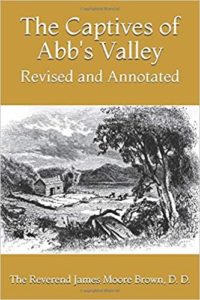The state of West Virginia was established in 1863 from the north-western portion of Virginia. It was the middle of the Civil War and a majority of Mountaineers believed they had more in common with the Union than the Confederacy. Two titles published this year provide some history of Presbyterians in the mountainous state. The first book, Presbyterianism in West Virginia: A History, was written by Dennis Bills, pastor of Trinity Presbyterian Church (PCA) in New Martinsville, and the second title, originally published in 1854, is The Captives of Abb’s Valley: Revised and Annotated with a biographical sketch of its author, Rev. James Moore Brown. The two books are published by Rev. Bills’s Reforming West Virginia with buying facilitated by links to a secure site. The author is an eighth-generation West Virginian, so the state is in his DNA.
Scanning my shelves I find three titles about Presbyterians in West Virginia—History of the Old Stone Presbyterian Church by Montgomery, History of the Presbytery of Kanawha which fulfilled the vision of Stated Clerk J. Blair Morton, and Historical Sketch of Greenbrier Presbytery by Price, which is available on this site in PDF.
 Rev. Bills’s first title has a photograph on its cover of the Old Stone Presbyterian Church in Lewisburg. The image shows the church’s double doors symbolizing its importance as the portal for spreading the gospel as interpreted by the Westminster Standards in West Virginia. His account unfolds in nine chapters beginning with the struggles settling the mountains and the persistence of frontiersman ministers establishing churches. A reoccurring problem in the era for Presbyterians was maintaining a supply of well-educated ministers with West Virginia not an exception. The political and social aspects leading to the Civil War divided state Presbyterians and the author points out the division of the churches according to their sectional sympathies. The book is well illustrated with most of the numerous photographs taken by the author when he visited historic sites mentioned in the book. Some of the individuals recounted are known to readers of Presbyterians of the Past such as Stuart Robinson, William S. Plumer, and the “Father of West Virginia Presbyterianism,” John McElhenney, but other ministers may not be familiar such as John McCue (1753-1818), Benjamin Grigsby (1770-1810), Henry Ruffner (1790-1861), and John C. Barr (1824-1911). Also included are several histories of older churches in the state. One aspect of the book that I found particularly helpful is the inclusion of small maps of West Virginia showing the counties in which particular congregations are situated. For example, when the stories of “Three North Central Churches” are told a map of the state is provided with the seven relevant counties marked. Chapter nine, “The Presbyterian Problem,” considers the current church situation in West Virginia and encourages ministers to persevere in shepherding and missions. The book concludes with a nice bibliography and two appendices, but there is not an index, which would have been helpful.
Rev. Bills’s first title has a photograph on its cover of the Old Stone Presbyterian Church in Lewisburg. The image shows the church’s double doors symbolizing its importance as the portal for spreading the gospel as interpreted by the Westminster Standards in West Virginia. His account unfolds in nine chapters beginning with the struggles settling the mountains and the persistence of frontiersman ministers establishing churches. A reoccurring problem in the era for Presbyterians was maintaining a supply of well-educated ministers with West Virginia not an exception. The political and social aspects leading to the Civil War divided state Presbyterians and the author points out the division of the churches according to their sectional sympathies. The book is well illustrated with most of the numerous photographs taken by the author when he visited historic sites mentioned in the book. Some of the individuals recounted are known to readers of Presbyterians of the Past such as Stuart Robinson, William S. Plumer, and the “Father of West Virginia Presbyterianism,” John McElhenney, but other ministers may not be familiar such as John McCue (1753-1818), Benjamin Grigsby (1770-1810), Henry Ruffner (1790-1861), and John C. Barr (1824-1911). Also included are several histories of older churches in the state. One aspect of the book that I found particularly helpful is the inclusion of small maps of West Virginia showing the counties in which particular congregations are situated. For example, when the stories of “Three North Central Churches” are told a map of the state is provided with the seven relevant counties marked. Chapter nine, “The Presbyterian Problem,” considers the current church situation in West Virginia and encourages ministers to persevere in shepherding and missions. The book concludes with a nice bibliography and two appendices, but there is not an index, which would have been helpful.
 The second title, The Captives of Abb’s Valley, focusses on the story of Mary Moore and her difficult frontier life as retold through the pen of her son, Rev. James Moore Brown (1799-1862). The narrative includes aspects common to antebellum biographical literature such as fighting Indians, which in Mary’s case led to her kidnapping and captivity, but then she escaped to find freedom and residence in Canada. Editor Bills has changed the chapter titles and provided helpful footnotes to explain antebellum terminology and events that were common knowledge of the day, while other notes deal with sources and additional information. The book provides a harrowing account, but as Brown notes, the providential work of God directed Mary Moore’s paths. For residents of Boston, Philadelphia, or New York seated in the comparative safety of their comfy parlors, Mary Moore’s story provided vicariously an experience of the frontier wilderness.
The second title, The Captives of Abb’s Valley, focusses on the story of Mary Moore and her difficult frontier life as retold through the pen of her son, Rev. James Moore Brown (1799-1862). The narrative includes aspects common to antebellum biographical literature such as fighting Indians, which in Mary’s case led to her kidnapping and captivity, but then she escaped to find freedom and residence in Canada. Editor Bills has changed the chapter titles and provided helpful footnotes to explain antebellum terminology and events that were common knowledge of the day, while other notes deal with sources and additional information. The book provides a harrowing account, but as Brown notes, the providential work of God directed Mary Moore’s paths. For residents of Boston, Philadelphia, or New York seated in the comparative safety of their comfy parlors, Mary Moore’s story provided vicariously an experience of the frontier wilderness.
Rev. Bills intends both Presbyterianism and Captives to be read as companion volumes; I read the former first, but I think the better approach would be to read the latter first. We should not forget the contributions of our ancestors in the faith, so reading these two titles helps us to remember the price paid by some to establish Presbyterian congregations committed to the Westminster Standards.
BARRY WAUGH
Notes—Rev. Bills provided the copies used for this review. The header image is from Pixabay and was located using the search “bookshelf” (there are several other nice pictures for bibliophiles).





